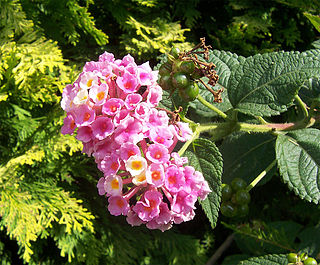
The Lamiaceae or Labiatae are a family of flowering plants commonly known as the mint, deadnettle, or sage family. Many of the plants are aromatic in all parts and include widely used culinary herbs like basil, mint, rosemary, sage, savory, marjoram, oregano, hyssop, thyme, lavender, and perilla, as well as other medicinal herbs such as catnip, salvia, bee balm, wild dagga, and oriental motherwort.

The Polygonaceae are a family of flowering plants known informally as the knotweed family or smartweed—buckwheat family in the United States. The name is based on the genus Polygonum, and was first used by Antoine Laurent de Jussieu in 1789 in his book, Genera Plantarum. The name may refer to the many swollen nodes the stems of some species have, being derived from Greek [poly meaning 'many' and gony meaning 'knee' or 'joint']. Alternatively, it may have a different origin, meaning 'many seeds'.

The Solanales are an order of flowering plants, included in the asterid group of the eudicots. Well-known members of Solanales include potatoes, eggplants, tomatoes, chilli peppers, tobacco, petunias, nightshades, morning glory, and sweet potato. Some older sources used the name Polemoniales for this order.

Boraginaceae, the borage or forget-me-notfamily, includes about 2,000 species of shrubs, trees, and herbs in 146 to 154 genera with a worldwide distribution.

The Verbenaceae, the verbena family or vervain family, is a family of mainly tropical flowering plants. It contains trees, shrubs, and herbs notable for heads, spikes, or clusters of small flowers, many of which have an aromatic smell.

The Celastraceae are a family of 98 genera and 1,350 species of herbs, vines, shrubs and small trees, belonging to the order Celastrales. The great majority of the genera are tropical, with only Celastrus, Euonymus and Maytenus widespread in temperate climates, and Parnassia (bog-stars) found in alpine and arctic climates.

Hydrophylloideae is a subfamily of the plant family Boraginaceae. Its taxonomic position is somewhat uncertain. Traditionally, and under the Cronquist system, the taxon was given family rank under the name Hydrophyllaceae, and treated as part of the order Solanales. More recent systems have recognised a close relationship to the borage family, Boraginaceae, initially by placing Hydrophyllaceae and Boraginaceae together in an order Boraginales, and in the 2016 APG IV system by including Hydrophyllaceae in Boraginaceae. However, the placement and circumscription of Boraginaceae is still uncertain. Some sources now split off Hydrophyllaceae again.

The Passifloraceae are a family of flowering plants, containing about 750 species classified in around 27 genera.

The Sapotaceae are a family of flowering plants belonging to the order Ericales. The family includes about 800 species of evergreen trees and shrubs in around 65 genera. Their distribution is pantropical.

Linaceae is a family of flowering plants. The family is cosmopolitan, and includes about 250 species in 14 genera, classified into two subfamilies: the Linoideae and Hugonioideae. Leaves of the Linaceae are always simple; arrangement varies from alternate to opposite or whorled. The hermaphroditic, actinomorphic flowers are pentameric or, very rarely, tetrameric.

Balanops is a group of flowering plants described as a genus in 1871. The nine species are trees or shrubs, found in New Caledonia, Fiji, Vanuatu, and northern Queensland. They are dioecious, with separate male and female plants.

The Polemoniaceae are a family of flowering plants consisting of about 27 genera with 270–400 species of annuals and perennials native to the Northern Hemisphere and South America, with the center of diversity in western North America.

Chrysobalanaceae is a family of flowering plants, consisting of trees and shrubs in 27 genera and about 700 species of pantropical distribution with a centre of diversity in the Amazon. Some of the species contain silica in their bodies for rigidity and so the mesophyll often has sclerenchymatous idioblasts. The widespread species Chrysobalanus icaco produces a plum-like fruit and the plant is commonly known as the coco plum.

Erythroxylaceae is a family of flowering trees and shrubs consisting of 4 genera and 271 species, native to Africa and South America. The four genera are AneulophusBenth., ErythroxylumP.Browne, NectaropetalumEngl., and PinacopodiumExell & Mendonça. The best-known species are the coca plants, including the species Erythroxylum coca, the source of the substance coca.

Lomandroideae is a subfamily of monocot flowering plants in the family Asparagaceae, order Asparagales, according to the APG III system of 2009. The subfamily name is derived from the generic name of the type genus, Lomandra. The group has previously been treated as a separate family Laxmanniaceae. In the Kubitzki system, it is treated as Lomandraceae Lotsy.

Phytolaccaceae is a family of flowering plants. Though almost universally recognized by taxonomists, its circumscription has varied. It is also known as the Pokeweed family.

Loasaceae is a family of 15–20 genera and about 200–260 species of flowering plants in the order Cornales, native to the Americas and Africa. Members of the family include annual, biennial and perennial herbaceous plants, and a few shrubs and small trees. Members of the subfamily Loasoideae are known to exhibit rapid thigmonastic stamen movement when pollinators are present.

Linderniaceae is a family of flowering plants in the order Lamiales, which consists of about 25 genera and 265 species occurring worldwide. Vandellia micrantha is eaten in Laos, but tastes bitter. Best known are the wishbone flowers Torenia fournieri and Torenia thouarsii, which are used as bedding plants, especially in the tropics. Micranthemum is sold as an aquarium plant under the name 'baby tears'.

Embelia is a genus of climbing shrubs once placed in the family Myrsinaceae, which is now included in the Primulaceae. There are about 130 species which occur in tropical and subtropical areas across a wide range including Africa and Madagascar and from eastern Asia to the Pacific Islands as well as Australia including:



















